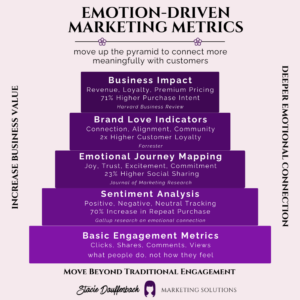In today’s data-saturated marketing landscape, we’ve become experts at tracking clicks, shares, views, and other surface-level engagement metrics. But these numbers only tell us what people do—not why they do it.
The missing ingredient? Emotion—the true catalyst that drives meaningful consumer action and business results.The Emotion-Driven Marketing Pyramid: A Framework for Deeper Connection
Marketing effectiveness isn’t just about reaching audiences; it’s about resonating with them. The Emotion-Driven Marketing Metrics Pyramid provides a framework for understanding how emotional connections drive business value:
Level 1: Basic Engagement Metrics
At the foundation, we find traditional metrics like clicks, shares, comments, and views. While valuable as indicators of reach and visibility, these metrics only capture behavior without explaining motivation.
Level 2: Sentiment Analysis
Moving up, sentiment analysis tracks positive, negative, and neutral responses to content. According to Gallup research, emotionally connected customers show a remarkable 70% increase in repeat purchases compared to those who aren’t emotionally engaged.
Level 3: Emotional Journey Mapping
This level delves into specific emotions like joy, trust, excitement, and commitment. The Journal of Marketing Research found that content triggering these emotions generates 23% higher social sharing—amplifying your reach organically.
Level 4: Brand Love Indicators
Here we measure deeper connections including alignment, community belonging, and brand affinity. Forrester research reveals emotionally engaged customers demonstrate 2x higher loyalty, translating to sustained revenue and reduced acquisition costs.
Level 5: Business Impact
At the pyramid’s peak, emotional connections translate directly to revenue, customer loyalty, and premium pricing power. Harvard Business Review reports that emotionally connected customers show 71% higher purchase intent—a direct path to improved bottom-line results.
Emotion as the Constants in an Ever-Changing Marketing Landscape
While marketing platforms and algorithms constantly evolve, human emotional responses remain remarkably consistent. This creates a durable foundation for marketing strategy that transcends tactical shifts.
Throughout my career working with brands of all sizes, I’ve seen emotion-centered campaigns increase visibility and engagement by nearly 200X while boosting action intent metrics by over 40%. These results weren’t achieved through technical optimization alone, but by deliberately designing content to evoke specific emotional responses.
How to Implement Emotion-Driven Metrics in Your Marketing
To elevate your marketing effectiveness, consider these approaches to emotional measurement and optimization:
1. Map the emotional journey of your customer experience, identifying moments where positive emotional connections can be strengthened and negative emotions addressed.
2. Conduct qualitative research beyond standard surveys. Use methods that uncover emotional responses customers might not explicitly verbalize.
3. Track sentiment alongside traditional metrics in your social media platform dashboards or listening, looking for correlations between emotional indicators and business outcomes.
4. Test content variations based on emotional triggers, not just rational messaging. Compare how different emotional approaches impact conversion rates.
5. Build community through shared values and emotions rather than transactional relationships.
The Competitive Advantage of Emotional Intelligence
In an era where brands compete for shrinking attention spans, emotional intelligence creates significant competitive advantage. The most shared, most effective content isn’t distinguished by clever copy or perfect visuals alone, but by its ability to create authentic emotional resonance.
Keeping a pulse on emotional value throughout your marketing campaigns and customer journeys isn’t just nice to have—it’s essential for maximizing ROI. When customers feel emotionally connected to your brand, they’re not just more likely to purchase once; they become advocates who amplify your message and remain loyal despite competitive offers.
The most successful marketers understand that while algorithms change daily and platforms come and go, the emotional connection remains the constant that drives sustainable results.
What emotions have you found most effective in driving your audience to action? How are you measuring emotional engagement in your marketing efforts? The answers to these questions might reveal your biggest opportunities for growth.
Adapted from research by Harvard Business Review, Forrester, Gallup, and the Journal of Marketing Research.

